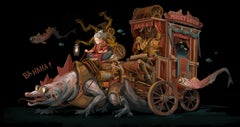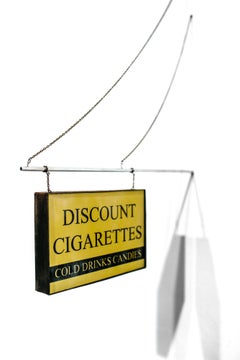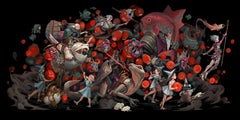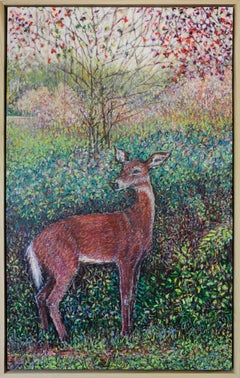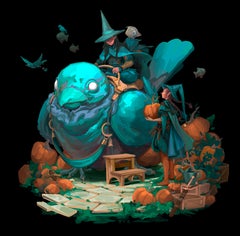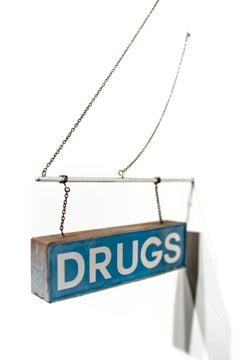Digital Still-life Drawings and Watercolors
to
1
7
1
1
2
Overall Width
to
Overall Height
to
1
10
1
10
1
4
3
6
4
2
2
2
2
2
1
1
1
1
1
1
1
1
1
16,674
1,392
1,284
989
366
4
1
1
4
10
Medium: Digital
Wanderer's Pizza
By Drew Leshko
Located in Philadelphia, PA
"Wanderer's Pizza" is an original paper, enamel, pastel, inkjet prints, chain, wire, and tubing artwork by Drew Leshko measuring approx. 11.5"h x 7.25"w x 0.75"d.
Drew Leshko is a P...
Category
2010s Contemporary Digital Still-life Drawings and Watercolors
Materials
Enamel, Wire
"Clown Fish" (2020) By Dustin Panzino, Procreate Illustration on Metal
Located in Denver, CO
"Clown Fish" (2020) by Dustin Panzino is a beautiful digital painting created in Procreate, which details a fantasy scene of a knighted version of a court's...
Category
2010s Contemporary Digital Still-life Drawings and Watercolors
Materials
Metal
"Puppet Show" By Dustin Panzino, Original Procreate Drawing Printed on Metal
Located in Denver, CO
"Puppet Show" (2024) By Dustin Panzino is a beautiful digital painting created in Procreate, which details a fantasy scene of an almost magical puppet show trolley, pulled along by a...
Category
2010s Contemporary Digital Still-life Drawings and Watercolors
Materials
Metal
Munchie's
By Drew Leshko
Located in Philadelphia, PA
"Munchie's" is an original paper, enamel, pastel, inkjet prints, chain, wire, and tubing artwork by Drew Leshko measuring approx. 11"h x 10.5"w x 0.75"d.
Drew Leshko is a Philadelph...
Category
2010s Contemporary Digital Still-life Drawings and Watercolors
Materials
Enamel, Wire
Discount Cigarettes
By Drew Leshko
Located in Philadelphia, PA
"Discount Cigarettes" is an original paper, enamel, pastel, inkjet prints, chain, wire, and tubing artwork by Drew Leshko measuring approx. 15"h x 10"w x 0.75"d.
Drew Leshko is a Ph...
Category
2010s Contemporary Digital Still-life Drawings and Watercolors
Materials
Enamel, Wire
"Cursed March" (2024) By Dustin Panzino, Procreate Illustration on Metal
Located in Denver, CO
"Cursed March" (2024) by Dustin Panzino is a beautiful digital painting created in Procreate, which details a renaissance style depiction of a parade of spirits, marching forward in ...
Category
2010s Contemporary Digital Still-life Drawings and Watercolors
Materials
Metal
"Witches Companion" By Dustin Panzino, Procreate Illustration on Metal
Located in Denver, CO
"Witches Companion" (2023) by Dustin Panzino is a beautiful digital painting created in Procreate, which details a fantasy scene of a cat-girl witch, riding atop her magical feline c...
Category
2010s Contemporary Digital Still-life Drawings and Watercolors
Materials
Metal
"Lantern Festival" (2022) By Dustin Panzino, Procreate Illustration on Metal
Located in Denver, CO
"Lantern Festival" (2022) by Dustin Panzino is a beautiful digital painting created in Procreate, which details a fantasy scene of an elven woman along with her child, excitedly trav...
Category
2010s Contemporary Digital Still-life Drawings and Watercolors
Materials
Metal
Tires
By Drew Leshko
Located in Philadelphia, PA
"Tires" is an original paper, enamel, pastel, inkjet prints, chain, wire, and tubing sculpture by Drew Leshko measuring approx. 11.5"h x 8.5"w x 0.75d.
Drew Leshko is a Philadelphia...
Category
2010s Contemporary Digital Still-life Drawings and Watercolors
Materials
Enamel, Wire
Only Chanel - 6"x6", Original Artwork On Paper, Pencil Logo, Black and White
Located in Mississauga, Ontario
Homage to the iconic Chanel logo. This pencil rendering is underlined with black textured paint making for a minimalistic outcome. With focus on simple composition, this artwork is d...
Category
2010s Contemporary Digital Still-life Drawings and Watercolors
Materials
Giclée
"Leaves & Berries" giclée print after ca. 1950s original watercolor and collage
Located in Milwaukee, WI
14.75 x 17.75 inches, artwork
22.88 x 25.75 inches, frame
Born in 1908, Sylvia Spicuzza was the daughter of noted painter Francesco Spicuzza. Sylvia devoted herself to teaching art ...
Category
1950s Modern Digital Still-life Drawings and Watercolors
Materials
Giclée, Watercolor
Related Items
Elsa Peretti goes out for a drink. From the Art, culture & society series
Located in Miami Beach, FL
Movies, TV and magazines are constant source of inspiration. Fame, as fleckring and shallow it can be sometimes, is very intriguing to him.
The worlds of fashion, society and pop cu...
Category
21st Century and Contemporary Contemporary Digital Still-life Drawings and Watercolors
Materials
Paper, Gouache, Ink
$500
H 12 in W 9 in D 0.1 in
"Walk" - oil pastel drawing, figurative, nature, deer, optical mixing, colorful
Located in Atlanta, GA
This piece is framed measuring 42 by 26 inches.
Based in Carrollton, Georgia, Erin Dixon is a mixed media artist whose work bridges realism and surrealism....
Category
2010s Contemporary Digital Still-life Drawings and Watercolors
Materials
Pastel, Canvas, Oil Pastel
"Some far away speech" Still life, Ink and watercolor
By Brian Spolans
Located in Philadelphia, PA
"Some far away speech" is an original ink and watercolor work on paper by Brian Spolans. The piece ships framed as pictured and measures 20.5in x 28.5in. Alternative custom framing...
Category
2010s Contemporary Digital Still-life Drawings and Watercolors
Materials
Ink, Watercolor, Archival Paper
Rick Owens Hollywood show. From the Fashion series
Located in Miami Beach, FL
The artist has covered New York collections for over 16 years and has interviewed, as a journalist, several fashion designers and personalities for different publications. He loves t...
Category
21st Century and Contemporary Contemporary Digital Still-life Drawings and Watercolors
Materials
Paper, Pencil, Gouache
$650
H 15 in W 11 in D 0.1 in
Intérieur Provence, Realistic Figurative original Drawing, Colorful, Interior
Located in AIX-EN-PROVENCE, FR
Coloured Pencils and pastel on Hahnemühle paper - Realistic Figurative original Drawing, Colorful, Interior.
Work Title : Intérieur Provence
Artist : Gabriel Riesnert...
Category
21st Century and Contemporary Contemporary Digital Still-life Drawings and Watercolors
Materials
Watercolor, Archival Paper, Color Pencil, Pastel
$418
H 6.3 in W 5.91 in D 0.08 in
"Yellow Butterflies" - pastel drawing, nature, plants, still life, landscape
Located in Atlanta, GA
This piece is framed measuring 27.5 by 35 inches.
Based in Carrollton, Georgia, Erin Dixon is a mixed media artist whose work bridges realism and surrealis...
Category
2010s Contemporary Digital Still-life Drawings and Watercolors
Materials
Pastel, Archival Paper
Black and white still life flower drawing of Mimosas by artist, Yvon Pissarro
Located in London, GB
Mimosas by Yvon Pissarro (b. 1937)
Graphite on paper
65 x 50 cm (25 ⅝ x 19 ⅝ inches)
Signed and dated lower left Yvon Vey 2002
Provenance
Studio of the artist, Montpellier
Artist b...
Category
Early 2000s Contemporary Digital Still-life Drawings and Watercolors
Materials
Graphite
$5,000
H 25.6 in W 19.69 in
"Cradle of Consequences" Sculpture 21" x 23" x 15" inch by Tetiana Kalivoshko
Located in Culver City, CA
"Cradle of Consequences" Sculpture 21" x 23" x 15" inch by Tetiana Kalivoshko
Unique sculpture
Medium: Concrete, plumbing steel pipes, steel replica hand grenades, steel vires
Teti...
Category
21st Century and Contemporary Contemporary Digital Still-life Drawings and Watercolors
Materials
Concrete, Steel, Wire
$5,750
H 21 in W 23 in D 15 in
"Summer" - nature, green, naturalism, oil painting, botanical
Located in Atlanta, GA
This piece is framed measuring 33 by 27 inches.
Based in Carrollton, Georgia, Erin Dixon is a mixed media artist whose work bridges realism and surrealism. Her work is often heavily...
Category
2010s Contemporary Digital Still-life Drawings and Watercolors
Materials
Canvas, Oil Pastel, Pastel
Un Enfant Vu Assis Sur
Located in Dallas, TX
Frédéric Bruly Bouabré
Un Enfant Vu Assis Sur
Ballpoint Pens, Crayons And Colored Pencil On Cardboard
7.5 x 5.5
March 11, 1948, he experienced ...
Category
21st Century and Contemporary Contemporary Digital Still-life Drawings and Watercolors
Materials
Crayon, Cardboard, Ballpoint Pen, Color Pencil
Des Enfants De Races Couler Ancenciel
Located in Dallas, TX
Frédéric Bruly Bouabré
Des Enfants De Races Couler Ancenciel
Ballpoint Pens, Crayons And Colored Pencil On Cardboard
5.5 x 7.5
March 11, 1948, ...
Category
21st Century and Contemporary Contemporary Digital Still-life Drawings and Watercolors
Materials
Crayon, Cardboard, Ballpoint Pen, Color Pencil
$480 Sale Price
73% Off
H 5.5 in W 7.5 in
Prada Bag Ladies, Fashion New York City 2021. Watercolor fashion drawing on pape
Located in Miami Beach, FL
The artist has covered New York collections for over 16 years and has interviewed, as a journalist, several fashion designers and personalities for different publications. He loves t...
Category
21st Century and Contemporary Contemporary Digital Still-life Drawings and Watercolors
Materials
Ink, Watercolor, Gouache, Pen
$700
H 12 in W 9 in D 0.1 in
Previously Available Items
"Sorcerer's Companion" By Dustin Panzino, Procreate Illustration on Metal
Located in Denver, CO
"Sorcerers Companion" (2023) by Dustin Panzino is a beautiful digital painting created in Procreate, which details a fantasy scene of a pair of elven sorcerers, packing up for a jour...
Category
2010s Contemporary Digital Still-life Drawings and Watercolors
Materials
Metal
"Drugs (rectangle)", Miniature wall-hanging paper sculpture, distressed, vintage
By Drew Leshko
Located in Philadelphia, PA
This miniature, wall-hanging, paper sculpture titled "Drugs (rectangle)" is an original paper, enamel, pastel, inkjet prints, chain, wire, and tubing artwork by Drew Leshko. The arti...
Category
21st Century and Contemporary Contemporary Digital Still-life Drawings and Watercolors
Materials
Enamel, Wire
Drugs (rectangle)
By Drew Leshko
Located in Philadelphia, PA
"Drugs (rectangle)" is an original paper, enamel, pastel, inkjet prints, chain, wire, and tubing artwork by Drew Leshko measuring approx. 8"h x 6"w x 0.75"d.
Drew Leshko is a Philad...
Category
2010s Contemporary Digital Still-life Drawings and Watercolors
Materials
Enamel, Wire
Bare Elegance
By Drew Leshko
Located in Philadelphia, PA
"Bare Elegance" is an original paper, enamel, pastel, inkjet prints, chain, wire, and tubing artwork by Drew Leshko measuring approx. 11”h x 7”w x 0.75”d.
Drew Leshko is a Philadelp...
Category
2010s Contemporary Digital Still-life Drawings and Watercolors
Materials
Enamel, Wire
Melrose Bar
By Drew Leshko
Located in Philadelphia, PA
"Melrose Bar" is an original paper, enamel, pastel, inkjet prints, chain, wire, and tubing artwork by Drew Leshko measuring approx. 10.5”h x 16.5”w x 0.75”d.
Drew Leshko is a Philad...
Category
2010s Contemporary Digital Still-life Drawings and Watercolors
Materials
Enamel, Wire
MySpace Lounge
By Drew Leshko
Located in Philadelphia, PA
"MySpace Lounge" is an original paper, enamel, pastel, inkjet prints, chain, wire, and tubing artwork by Drew Leshko measuring approx. 13"h x 7.5"w x 0.75"d.
Drew Leshko is a Philad...
Category
2010s Contemporary Digital Still-life Drawings and Watercolors
Materials
Enamel, Wire
Lovely Baptist Church
By Drew Leshko
Located in Philadelphia, PA
"Lovely Baptist Church" is an original paper, enamel, pastel, inkjet prints, chain, wire, and tubing artwork by Drew Leshko measuring approx. 18"h x 7.5"w x 0.75"d.
Drew Leshko is a...
Category
2010s Contemporary Digital Still-life Drawings and Watercolors
Materials
Enamel, Wire
The Last Shot
By Drew Leshko
Located in Philadelphia, PA
"The Last Shot" is an original paper, enamel, pastel, inkjet prints, chain, wire, and tubing artwork by Drew Leshko measuring approx. 11"h x 8"w x 0.75"d.
P...
Category
2010s Contemporary Digital Still-life Drawings and Watercolors
Materials
Enamel, Wire
Drugs (arrow light blue)
By Drew Leshko
Located in Philadelphia, PA
"Drugs (arrow light blue)" is an original paper, enamel, pastel, inkjet prints, chain, wire, and tubing artwork by Drew Leshko measuring approx. 8"h x 6"w x 0.75"d.
Please note: art...
Category
2010s Contemporary Digital Still-life Drawings and Watercolors
Materials
Enamel, Wire
Cocktails (black)
By Drew Leshko
Located in Philadelphia, PA
"Cocktails (black)" is an original paper, enamel, pastel, inkjet prints, chain, wire, and tubing artwork by Drew Leshko measuring approx. 8"h x 4.5"w x 0.75"d.
Please note: artwork ...
Category
2010s Contemporary Digital Still-life Drawings and Watercolors
Materials
Enamel, Wire
Fifth Avenue Shoes
By Drew Leshko
Located in Philadelphia, PA
"Fifth Avenue Shoes" is an original paper, enamel, pastel, inkjet prints, chain, wire, and tubing artwork by Drew Leshko measuring approx. 14"h x 7"w x 0.75"d.
Drew Leshko is a Phil...
Category
2010s Contemporary Digital Still-life Drawings and Watercolors
Materials
Enamel, Wire
Cocktails (green)
By Drew Leshko
Located in Philadelphia, PA
"Cocktails (green)" is an original paper, enamel, pastel, inkjet prints, chain, wire, and tubing artwork by Drew Leshko measuring approx. 9"h x 7"w x 0.75"d.
Drew Leshko is a Philad...
Category
2010s Contemporary Digital Still-life Drawings and Watercolors
Materials
Enamel, Wire
Digital still-life drawings and watercolors for sale on 1stDibs.
Find a wide variety of authentic Digital still-life drawings and watercolors available on 1stDibs. While artists have worked in this medium across a range of time periods, art made with this material during the 21st Century is especially popular. If you’re looking to add still-life drawings and watercolors created with this material to introduce a provocative pop of color and texture to an otherwise neutral space in your home, the works available on 1stDibs include elements of blue and other colors. There are many well-known artists whose body of work includes ceramic sculptures. Popular artists on 1stDibs associated with pieces like this include Drew Leshko, David Barnett, Cristina Torrecilla, and Andrea Stajan-Ferkul. Frequently made by artists working in the Contemporary, Modern, all of these pieces for sale are unique and many will draw the attention of guests in your home. Not every interior allows for large Digital still-life drawings and watercolors, so small editions measuring 0.1 inches across are also available Prices for still-life drawings and watercolors made by famous or emerging artists can differ depending on medium, time period and other attributes. On 1stDibs, the price for these items starts at $38 and tops out at $1,450,000, while the average work can sell for $981.


